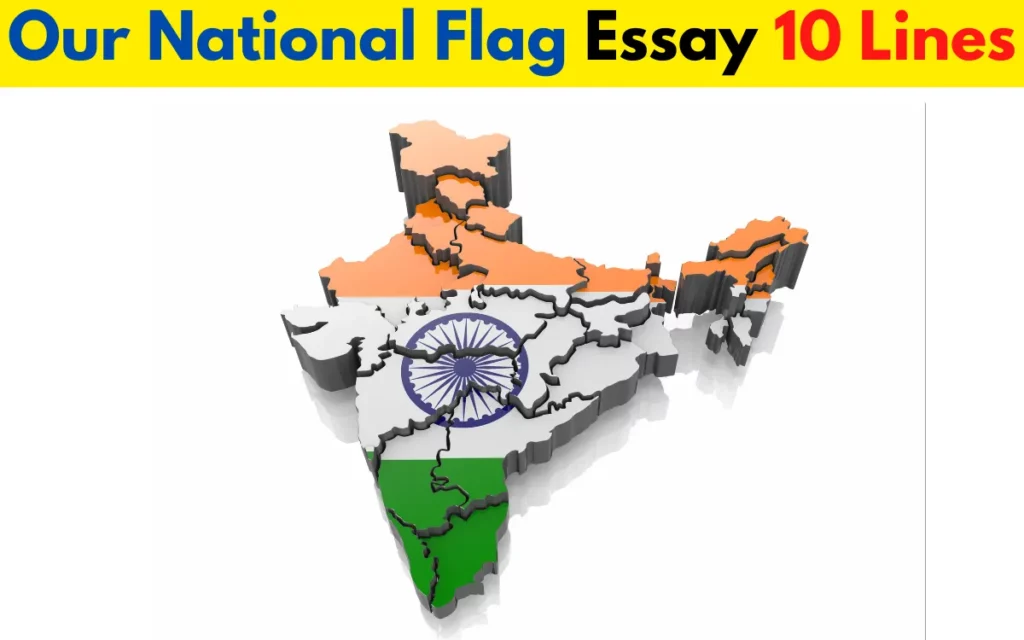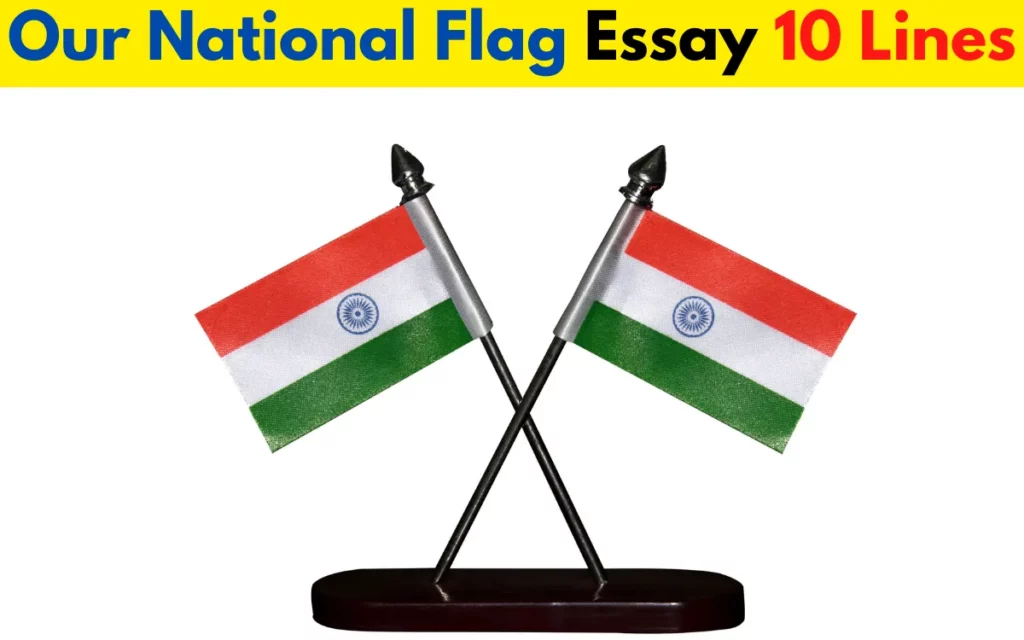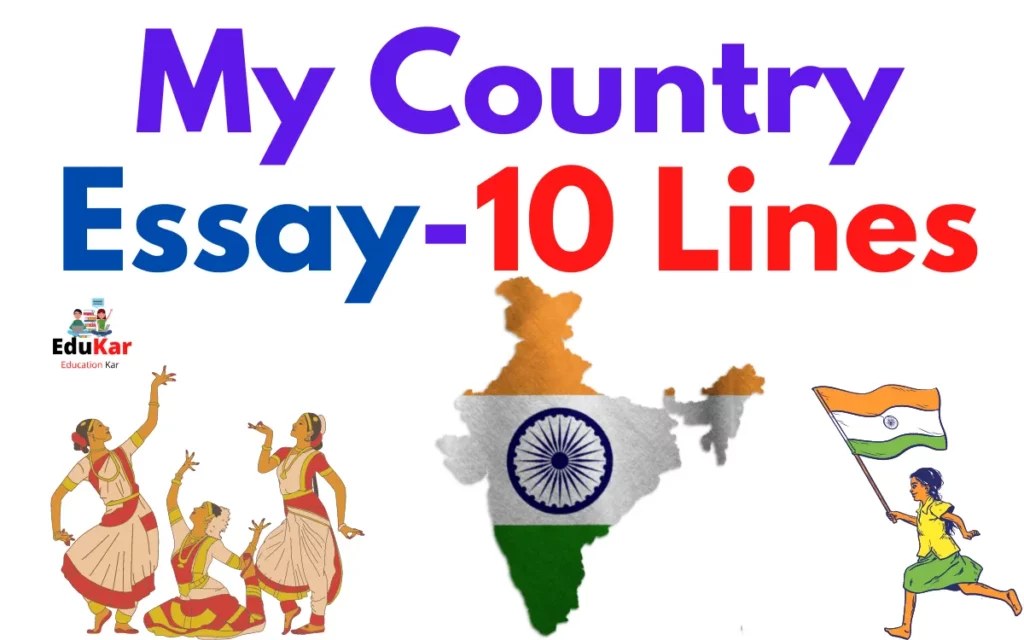Contents
- 1 Essay 1- Our National Flag Essay 10 lines
- 2 Essay 2- Our National Flag Essay 10 lines
- 3 Essay 3- Our National Flag Essay 10 lines
- 4 Essay 4- Our National Flag Essay 10 lines
- 5 Essay 5- Our National Flag Essay 10 lines
- 6 FAQs for “Our National Flag Essay in 10 lines”
- 6.1 Q: What are the colors of the Indian national flag?
- 6.2 Q: What does the saffron color on the flag represent?
- 6.3 Q: What is the significance of the blue wheel in the center of the flag?
- 6.4 Q: Who designed the Indian national flag?
- 6.5 Q: When was the Indian national flag officially adopted?
- 6.6 Q: When is the Indian national flag hoisted?
- 6.7 Q: What is expected of Indian citizens when the national flag is hoisted?
- 6.8 Q: What are the rules governing the usage and display of the Indian national flag?
- 6.9 Q: What is the significance of the Indian national flag?
The Indian national flag is a symbol of national pride and unity for the people of India. It is a tricolor flag consisting of three horizontal bands of saffron, white, and green, with a blue wheel in the center known as the Ashoka Chakra. n this essay, we will discuss the significance of the Indian national flag in 10 points.

Essay 1- Our National Flag Essay 10 lines

- Our national flag, also known as the Tiranga, is a symbol of our nation’s unity, integrity and pride.
- The flag is a horizontal tricolor of deep saffron at the top, white in the middle and dark green at the bottom in equal proportions.
- The Ashok Chakra, a navy blue wheel with 24 spokes in the center of the white band represents the Dharma Chakra, the wheel of law in the Sarnath Lion Capital made by Emperor Ashoka.
- The saffron color represents sacrifice and spiritual strength.
- The white color represents peace and truth.
- The green color represents faith and fertility.
- It was adopted on 22 July 1947 by the Constituent Assembly of India.
- The flag was designed by Pingali Venkayya.
- It is mandatory for all government buildings to hoist the flag on Independence Day and Republic Day.
- The national flag is also flown at half-mast as a mark of respect during national mourning.
Essay 2- Our National Flag Essay 10 lines

- The national flag of a country represents its identity and symbolizes its values and principles.
- The national flag of India is known as the “Tiranga,” which means “tricolor.”
- The flag is a horizontal tricolor of deep saffron (kesaria) at the top, white in the middle, and dark green at the bottom in equal proportions.
- The saffron color represents sacrifice and spiritual purity, white represents peace and truth, and green represents faith and fertility.
- The flag was designed by Pingali Venkayya in 1921 and was officially adopted by the Constituent Assembly on July 22, 1947.
- The flag has a wheel with 24 spokes in the center, known as the Ashoka Chakra.
- The Ashoka Chakra represents the wheel of law and order, and it symbolizes progress and continuity.
- The flag is to be hoisted on national holidays, such as Independence Day and Republic Day, as well as on other important occasions.
- It is also mandatory for all government buildings and public offices to hoist the national flag.
- The national flag is a symbol of pride for all citizens and should be treated with respect and dignity at all times.
Essay 3- Our National Flag Essay 10 lines

- The Indian national flag, also known as the “Tiranga,” features three horizontal stripes of equal width.
- The top stripe is saffron in color, the middle stripe is white, and the bottom stripe is green.
- The saffron color represents courage and sacrifice, the white color represents peace and truth, and the green color represents faith and chivalry.
- The Ashok Chakra, a blue wheel with 24 spokes, is located in the center of the white stripe.
- The Ashok Chakra represents the eternal wheel of law and justice.
- The flag was designed by Pingali Venkayya in 1921, and was officially adopted by the Constituent Assembly of India on July 22, 1947.
- The Indian national flag has a ratio of 2:3, with the length being twice the width.
- The flag is to be made of khadi, a type of hand-spun cloth made from cotton, silk, or wool.
- The national flag should be flown with respect and with the saffron stripe at the top.
- The Indian national flag represents the unity and diversity of India and is a symbol of national pride.
Essay 4- Our National Flag Essay 10 lines

- The Indian national flag, also known as the “Tiranga,” is a tricolor flag consisting of three horizontal bands of saffron, white, and green.
- The saffron color represents courage, sacrifice, and the spirit of renunciation.
- The white color represents peace, unity, and truth.
- The green color represents faith and chivalry.
- The blue wheel in the center of the flag, known as the Ashoka Chakra, represents the eternal wheel of law and justice.
- The flag was designed by Pingali Venkayya, a freedom fighter and agriculturist from Andhra Pradesh.
- The flag was officially adopted by the Indian Constituent Assembly on July 22, 1947.
- The national flag is hoisted on Independence Day, Republic Day, and other national holidays.
- Indian citizens are expected to show respect to the national flag by standing at attention and saluting the flag during the national anthem.
- The flag code of India, 2002 governs the usage and display of the national flag.
Essay 5- Our National Flag Essay 10 lines

- The Indian national flag, also known as the “Tiranga,” was designed by Pingali Venkayya in 1921.
- The flag is a horizontal tricolor of deep saffron (kesaria) at the top, white in the middle and dark green at the bottom in equal proportion.
- The saffron color symbolizes courage and sacrifice, the white represents peace and truth, and the green symbolizes faith and chivalry.
- The Ashoka Chakra in navy blue at the center of the white band represents the wheel of law and order and has 24 spokes.
- The flag was first hoisted on August 15, 1947, the day India gained independence from British rule.
- The flag is to be made of khadi, a type of hand-spun cloth, as a symbol of India’s self-reliance.
- The flag code of India governs the usage and display of the national flag.
- The flag should be flown with respect and should not be flown at half-mast except on occasions of national mourning.
- The flag should not be used for commercial or business purposes.
- The national flag is a symbol of unity and national pride for all Indians and should be respected and honored.
FAQs for “Our National Flag Essay in 10 lines”
Q: What are the colors of the Indian national flag?
A: The Indian national flag is a tricolor flag consisting of three horizontal bands of saffron, white, and green.
Q: What does the saffron color on the flag represent?
A: The saffron color represents courage, sacrifice, and the spirit of renunciation.
Q: What is the significance of the blue wheel in the center of the flag?
A: The blue wheel in the center of the flag, known as the Ashoka Chakra, represents the eternal wheel of law and justice.
Q: Who designed the Indian national flag?
A: The Indian national flag was designed by Pingali Venkayya, a freedom fighter and agriculturist from Andhra Pradesh.
Q: When was the Indian national flag officially adopted?
A: The Indian national flag was officially adopted by the Indian Constituent Assembly on July 22, 1947.
Q: When is the Indian national flag hoisted?
A: The Indian national flag is hoisted on Independence Day, Republic Day, and other national holidays.
Q: What is expected of Indian citizens when the national flag is hoisted?
A: Indian citizens are expected to show respect to the national flag by standing at attention and saluting the flag during the national anthem.
Q: What are the rules governing the usage and display of the Indian national flag?
A: The rules governing the usage and display of the Indian national flag are outlined in the flag code of India, 2002.
Q: What is the significance of the Indian national flag?
A: The Indian national flag is a symbol of national pride and unity for the people of India, and each color holds a significant meaning representing various values of the country.






